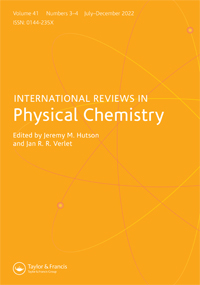Water and its partially dissociated fragments at metal surfaces
IF 2.5
2区 化学
Q3 CHEMISTRY, PHYSICAL
引用次数: 13
Abstract
Abstract Water and its fragments are present on metal surfaces under all but the most extreme conditions, acting both as a reactive species and as a ligand in ways that have yet to be fully explored. This review focuses on experimental studies of the chemical species and hydrogen bonding structures that form in the first layer adsorbed on a metal surface. The development of non-invasive probes that avoid dissociating water, or disrupting fragile bonding structures, now allows experiments to distinguish between different structural models for water and its fragments at the surface, allowing us to test the accuracy of modern structural calculations and provide a better picture of how the metal surface influences the structures and chemical species present. We start by describing the behaviour of Pt(1 1 1), whose redox chemistry is important in electrochemical fuel cells and has been studied in detail, providing a good reference system against which to discuss the effect changing the surface symmetry and metal reactivity has on the interface structure. Evidence for the presence and the role of hydroxyl and hydrated ‘hydronium’ species is described and we discuss the outlook for future experiments and identify some questions that remain to be resolved.金属表面的水及其部分分离的碎片
除了最极端的条件外,水及其碎片在所有金属表面上都存在,它们既作为一种活性物质,又作为一种配体,其方式尚未得到充分的探索。本文综述了金属表面吸附第一层中形成的化学物质和氢键结构的实验研究。非侵入性探针的发展,避免了水的解离,或破坏脆弱的键合结构,现在允许实验区分水及其表面碎片的不同结构模型,使我们能够测试现代结构计算的准确性,并提供一个更好的金属表面如何影响结构和化学物质存在的图片。我们首先描述Pt(11 11)的行为,它的氧化还原化学在电化学燃料电池中很重要,并且已经被详细研究过,为讨论改变表面对称性和金属反应性对界面结构的影响提供了一个很好的参考体系。描述了羟基和水合氢离子存在和作用的证据,并讨论了未来实验的前景,并确定了一些有待解决的问题。
本文章由计算机程序翻译,如有差异,请以英文原文为准。
求助全文
约1分钟内获得全文
求助全文
来源期刊
CiteScore
14.20
自引率
1.60%
发文量
5
审稿时长
1 months
期刊介绍:
International Reviews in Physical Chemistry publishes review articles describing frontier research areas in physical chemistry. Internationally renowned scientists describe their own research in the wider context of the field. The articles are of interest not only to specialists but also to those wishing to read general and authoritative accounts of recent developments in physical chemistry, chemical physics and theoretical chemistry. The journal appeals to research workers, lecturers and research students alike.

 求助内容:
求助内容: 应助结果提醒方式:
应助结果提醒方式:


